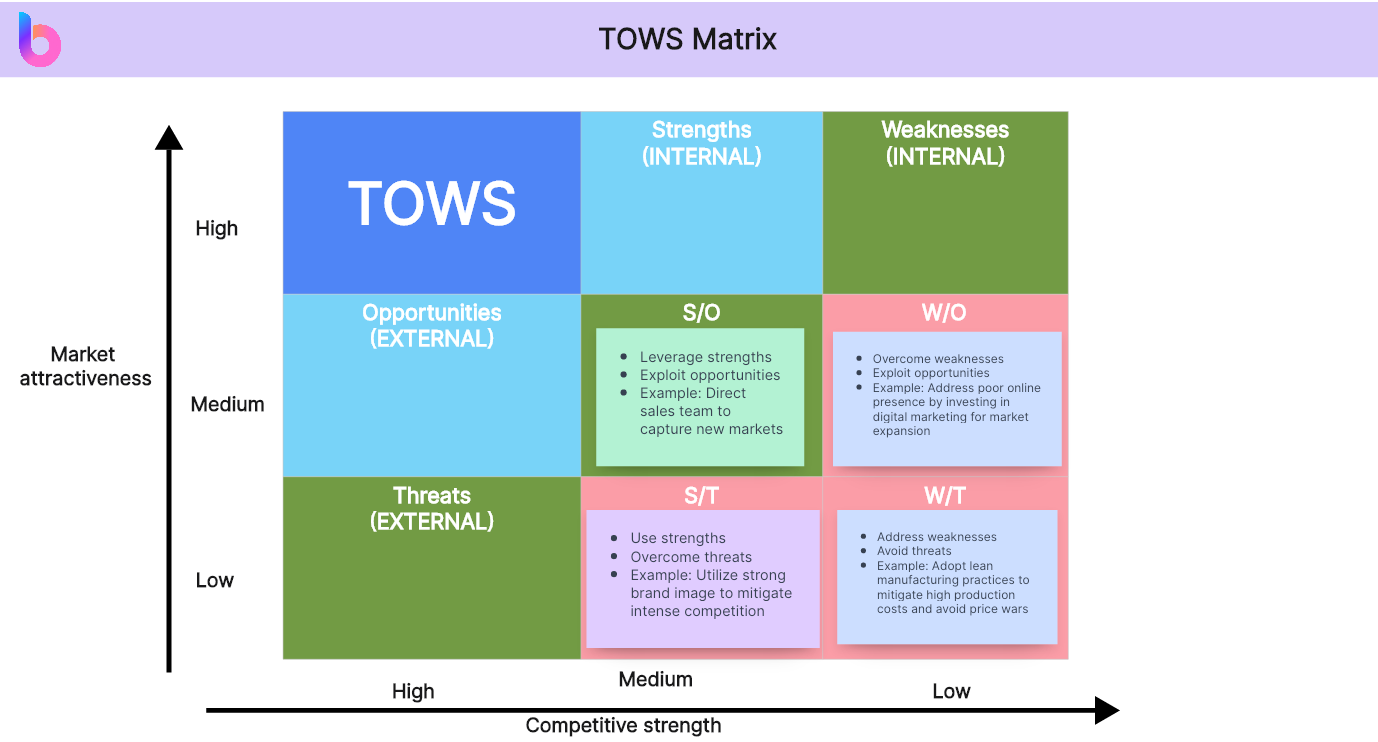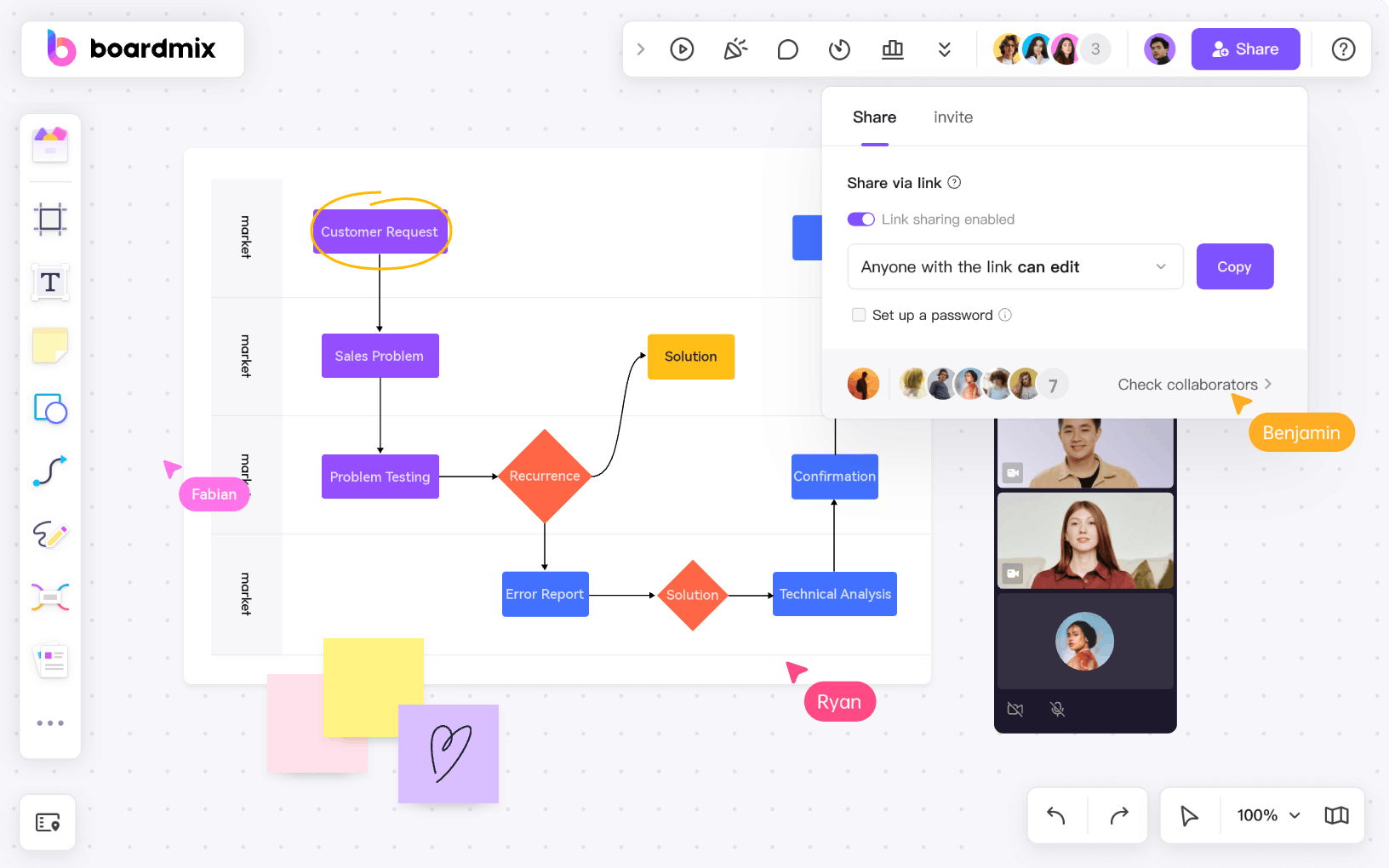Imagine having a roadmap that not only highlights your business strengths and weaknesses but also points out opportunities and threats in your environment. That's the TOWS Matrix for you. It's not a magic wand, but a tool that simplifies complexity, turning bewildering data into actionable insights. So, are you ready to embark on this journey of strategic enlightenment with the TOWS Matrix? Let's begin by demystifying what it is and how it can fuel your business growth.
Introduction to TOWS Matrix
The world of strategic planning is teeming with tools and models designed to help organizations make informed decisions. One such tool, often underrated but of paramount importance, is the TOWS Matrix. Not to be confused with the SWOT analysis (although it's closely related), the TOWS Matrix offers a more nuanced approach to evaluating an organization's Strengths, Weaknesses, Opportunities, and Threats.

The acronym TOWS is derived from these four components - Threats, Opportunities, Weaknesses, and Strengths. The matrix provides a framework to strategically analyze these elements and aids in developing action plans that take into account both internal and external factors. It encourages businesses to consider how they can capitalize on their strengths and opportunities and mitigate their weaknesses and threats.
Decipher the Four Quadrants of TOWS Matrix
The TOWS Matrix is divided into four quadrants, each offering a unique perspective on the organization's strategic positioning.
- Quadrant 1: Strengths-Opportunities (SO): This quadrant focuses on how a business can leverage its strengths to seize identified opportunities. This may involve maximizing core competencies or utilizing resources efficiently.
- Quadrant 2: Strengths-Threats (ST): Here, the focus shifts towards utilizing the organization's strengths to mitigate potential threats. A solid financial position or strong brand reputation may enable a company to counteract market volatility or new competitors.
- Quadrant 3: Weaknesses-Opportunities (WO): This segment identifies ways to overcome weaknesses by tapping into opportunities. For instance, by investing in technology, a company may address operational inefficiencies and exploit an emerging market trend.
- Quadrant 4: Weaknesses-Threats (WT): The final quadrant outlines defensive strategies to curb identified weaknesses and fend off threats. This might involve measures to improve poor customer service or strategies to guard against regulatory changes.
Importance of TOWS Matrix in Strategic Planning
The TOWS Matrix forms a vital component of strategic planning due to several reasons:
- Improved Decision-making: By providing a comprehensive overview of strengths, weaknesses, opportunities, and threats, TOWS aids in informed decision-making.
- Strategic Alignment: The Matrix promotes strategic alignment by ensuring all actions are consistent with the organization's overall objectives and resources.
- Risk Mitigation: It helps identify potential threats early on and devise strategies to mitigate those risks.
- Competitive Advantage: By leveraging strengths and opportunities while addressing weaknesses and threats, organizations can establish a robust competitive advantage.
The TOWS Matrix plays a vital role in aiding strategic decision-making within organizations. Its ability to enable systematic analysis of internal and external factors makes it an invaluable tool in the strategic planning process.
Differences between TOWS and SWOT Analysis
In the arena of strategic planning, both TOWS Matrix and SWOT Analysis are popular tools used by organizations to identify their Strengths, Weaknesses, Opportunities, and Threats. Despite their similar acronyms, these two techniques have different focuses and applications in business strategy.
Origin and Development
The SWOT Analysis was first introduced in the 1960s as a tool to help organizations identify their internal Strengths and Weaknesses, as well as external Opportunities and Threats. The goal was to analyze the current situation and inform decision-making.
The TOWS Matrix, on the other hand, was developed in the early 1980s by Heinz Weihrich as an enhancement of SWOT Analysis. Its objective was not just to analyze but to develop strategic options based on the analysis.
Focus and Approach
SWOT Analysis mainly serves as a descriptive tool that lists an organization's Strengths, Weaknesses, Opportunities, and Threats in a tabular format. It's often used as a starting point for strategy formulation but lacks clear directions on how to use the identified elements.
Contrarily, the TOWS Matrix takes a prescriptive approach. It goes beyond simply identifying the components to pairing them strategically in a matrix. The combinations (Strengths-Opportunities, Strengths-Threats, Weaknesses-Opportunities, and Weaknesses-Threats) generate strategic alternatives for the organization.
Depth of Strategic Insight
While SWOT Analysis helps identify key internal and external factors affecting an organization, it does not provide deep strategic insights or actions. Often, businesses struggle to convert their SWOT findings into actionable strategies.
The TOWS Matrix fills this gap by systematically connecting strengths, weaknesses, opportunities, and threats. It not only identifies these components but also provides a roadmap for creating effective strategies based on these interactions.
Ease of Use
SWOT Analysis is often preferred for its simplicity and straightforwardness. It's easy to understand and can be used by anyone without much strategic planning experience.
However, the TOWS Matrix requires a deeper understanding of strategy development. Its focus on deriving strategies from the interplay of SWOT components can be more complex to implement.
In summary, while TOWS Matrix and SWOT Analysis have similar elements, they differ significantly in their focus, depth of strategic insight, and application. Choosing between them largely depends on an organization's strategic planning needs and objectives.
A Step-by-step Approach to Building Your TOWS Matrix
The TOWS Matrix is an effective tool for strategic planning, providing a roadmap for an organization to leverage its strengths, overcome weaknesses, exploit opportunities, and mitigate threats. Here is a step-by-step approach to building a robust TOWS Matrix.
Step 1: Conduct a SWOT Analysis
The first step in creating a TOWS Matrix involves conducting a SWOT Analysis. This entails identifying your organization's Strengths, Weaknesses, Opportunities, and Threats.
Strengths and Weaknesses are internal factors, such as resources, processes, or capabilities. Opportunities and Threats, on the other hand, are external elements such as market trends, competition, or regulatory environment.
Step 2: Set Up Your TOWS Matrix
Once you have your SWOT components identified, you can set up the TOWS Matrix. Draw a square and divide it into four equal quadrants. Label the top-left quadrant as SO (Strengths-Opportunities), top-right as ST (Strengths-Threats), bottom-left as WO (Weaknesses-Opportunities), and bottom-right as WT (Weaknesses-Threats).
Step 3: Fill In the Quadrants
Now it's time to fill in each quadrant of the TOWS Matrix with strategic actions:
- SO Strategies: In this quadrant, you will list strategies that leverage your strengths to take advantage of opportunities. For example, if a strength is your experienced sales team and an opportunity is an emerging market, your strategy could be to direct your sales team to capture the new market.
- ST Strategies: Here you'll write strategies that use your strengths to overcome potential threats. A strength like a strong brand image can be used to mitigate threats like intense competition.
- WO Strategies: This quadrant should contain strategies that seek to overcome weaknesses by exploiting opportunities. If poor online presence (weakness) is hindering market expansion (opportunity), then a strategy could be investing in digital marketing.
- WT Strategies: Finally, list strategies that address weaknesses and avoid threats in this quadrant. If high production costs (weakness) expose you to threats like price wars, then adopting lean manufacturing practices might be a suitable strategy.

Step 4: Prioritize and Implement Strategies
After filling in the quadrants, the next step is prioritization. Not all strategies can be implemented at once, so rank them based on their potential impact, feasibility, and alignment with your business goals. Once prioritized, strategies can then be implemented through specific actions and tasks.
The TOWS Matrix provides a comprehensive framework for strategic planning that goes beyond the standard SWOT Analysis. With this step-by-step guide, you are well equipped to build your TOWS Matrix and navigate your business toward successful outcomes.
How to Incorporate the TOWS Matrix in Boardmix
Boardmix is a powerful software tool designed for board members and governance professionals to streamline board-related tasks. While the application itself doesn't include a specific feature for a TOWS Matrix, you can still incorporate TOWS Matrix analysis into your Boardmix routine by using available features. Here's how:

Step 1: Creating a New Board
Create a new board within Boardmix for your TOWS analysis. You can use the TOWS matrix template provided within the platform to input your content.
Step 2: Categorizing Information
Boardmix allows you to categorize documents for easy reference and navigation. Make sure you categorize this TOWS Matrix document appropriately, such as under "Strategic Planning" or "Board Meetings."
Step 3: Sharing the TOWS Matrix
Once you've created and categorized the TOWS Matrix, share it with other board members and stakeholders using Boardmix's collaboration features. This can include sharing within specific meeting folders or through direct sharing capabilities.
Step 4: Facilitating Discussion
Use Boardmix's discussion and annotation features to facilitate dialogue around the TOWS Matrix. This could involve creating threads for each quadrant of the matrix or for individual strategies. This will allow board members to provide input and feedback.
Step 5: Archiving and Referencing
Once discussions are completed and strategies are agreed upon, ensure the TOWS Matrix is archived correctly for future reference. Use Boardmix's archiving features to store this crucial strategic document safely.
By following these steps, you can effectively integrate the TOWS Matrix into your Boardmix processes. Although this requires some manual input, it offers an excellent way to centralize strategic discussions and enhance decision-making processes.
Common Mistakes to Avoid When Using TOWS Matrix
The TOWS Matrix is a potent strategic tool, but like any other instrument, its effectiveness can be compromised if not properly used. Here are common mistakes to avoid when using the TOWS Matrix.
- Lack of Thorough SWOT Analysis
A TOWS Matrix relies heavily on the SWOT analysis. Therefore, not conducting a thorough SWOT analysis could limit the effectiveness of your TOWS Matrix. Avoid generic or shallow analysis, and invest time and effort in identifying specific, relevant, and comprehensive strengths, weaknesses, opportunities, and threats.
- Ignoring the Interrelationships
The value of the TOWS Matrix lies in its ability to highlight interrelationships between internal and external factors. Ignoring these connections and treating each quadrant as an isolated entity is a common mistake that diminishes the utility of the matrix. Be mindful of these relationships and draw connections wherever possible.
- Lack of Prioritization
Filling out the TOWS Matrix could lead to a multitude of strategic actions. However, attempting to pursue all at once can result in spreading resources too thin and achieving little. Avoid this mistake by prioritizing the strategies based on their feasibility, alignment with organizational objectives, and potential impact.
- Overlooking Internal Capabilities
While using the TOWS Matrix, there's a tendency to focus excessively on external factors (opportunities and threats), while overlooking the role of internal capabilities (strengths and weaknesses). Always ensure that strategies developed are within your organization's ability to execute.
- Failure to Review and Update
The business environment is dynamic. Therefore, a TOWS Matrix based on outdated SWOT components could lead to ineffective strategies. A common mistake is to fail to regularly review and update your TOWS Matrix.
- Viewing It as a One-size-fits-all Tool
It's important to understand that the TOWS Matrix isn't a universal solution for every strategic challenge. Trying to force every situation into the matrix could lead to inappropriate strategies.
Avoiding these common pitfalls will ensure you derive maximum value from your TOWS Matrix, enabling better strategic planning and decision-making.









